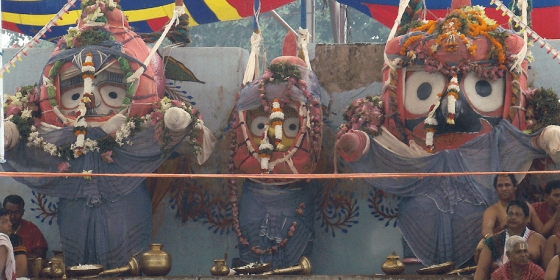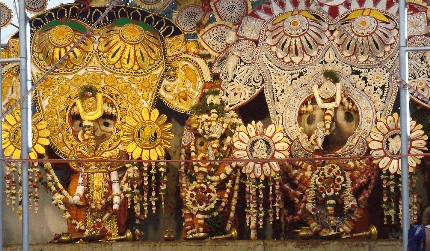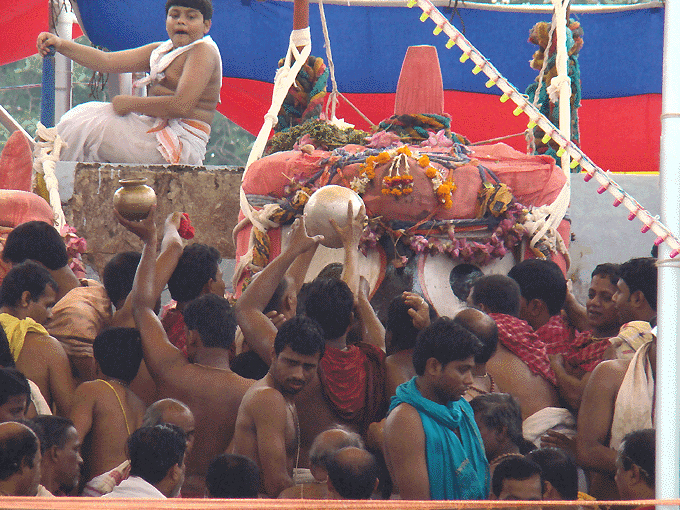
A
very special and sacred festival of Lord Jagannath held in the full-moon day of
the month of Jyestha. This festival is known as 'Devasnan Purnima' or 'Snana Yatra'
(Bathing Festival). There is a general belief that the devotee washes away all his
sins if he gets a vision of the Lord on this day, therefore, it attracts thousands
of pilgrims from all over the world. According to Skanda Purana when King Indradyumna
installed the wooden deities he arranged this bathing ceremony.
On the previous
day of Snana Yatra the images of Lord Jagannath, Lord Balabhadra and Goddess Subhadra
along with the image of Sudarshana are ceremonially brought out from the inner sanctum
of the main temple in a procession (called 'Pahandi' in local language) to the Snana
Mandapa (Bathing pandal). This bathing platform is situated to the north-east of
Ananda Bazar and besides the outer wall of the temple (called Meghanada Pacheri
in local language).The length and breadth of this bathing platform is 76 feet. It
is at such a height that visitors standing outside the temple also get a clear view
of the Deities.

On this auspicious day the Suaras and Mahasuaras go in a ceremonial
procession to fetch 108 pots of water from the Golden well (called 'Suna Kua' in
local language). The holy water drawn from this well once a year. During the entire
process all of them cover their mouths with a piece of cloth so as not to contaminate
it even with their breath.
Then all the pots filled with water are preserved in
the Bhoga Mandap. Then the priests purify the water with Haladi (turmeric), Java
(whole rice), Sandal (Chandan), flowers and perfumes. The filled and purified water
pots then carried from Bhoga Mandap to the bathing platform by the Suaras in a long
single line queue. This ritual is called 'Jalabhisheka'. 'Jalabhishek' consists
of two words 'Jala' and 'Abhisheka'. In local language 'Jala' means water and 'Abhishek'
means Bath. This Abhiseka is accompanied by chanting of vedic mantras by the priests,
kirtana and blowing of conch shells.

At evening, after the bath ritual, the Deities assume
the special elephant form which is otherwise known as 'Hati Vesha'. Lord Jagannatha
and Lord Balaram dressed like elephant, and Goddess Subhadra wears a lotus flower
vesha.
|
After Snana Yatra, the deities are supposed to fall ill (fever) and do not
return to their pedestal. The Deities are kept on a special sick room called the
'Ratan vedi' inside the temple. They stay away from the public view for a period
of 15 days. This period is known as 'Anasara'. During Anasara the Deities offered
only fruits and water mixed with cheese and Dasamula medicines to cure from fever.
The Deities are treated by the Raj Vaidya (the King's physician) with specific medicines
(Dasamulas). During all these days the daily rites of the temple remain suspended.
Due to the sacred bath with 108 pitchers of water, the colours painted on the images
fade out. The Daitas repaint the images with new colors and on the 16th day the
Deities appear in their new forms after colouration become ready for the public
view. The festival of the first appearance of the Lord Jagannath to his devotees
is called 'Netrotsava' (festival for the eyes) or 'Nava Yauvanotsava' (festival
of the ever new youth).
|
|



